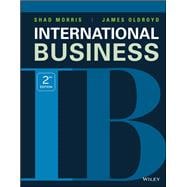Leveraging their extensive background at multi-national corporations, co-authors Shad Morris and James Oldroyd created an International Business course that is current, concise, and easy to implement. As instructors themselves, the authors focused on engaging pedagogy that prepares students for the global marketplace and created interactive resources to deepen the learning experience.
This second edition of International Business includes extensive updates including coverage on important topics like COVID-19, Brexit and the US-China trade war. Additionally, the WileyPLUS course provides just-in-time resources like chapter introductory videos, whiteboard animations, cases/case application problems, adaptive practice, and more to help students apply their learning and think critically.








